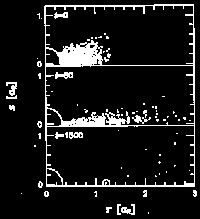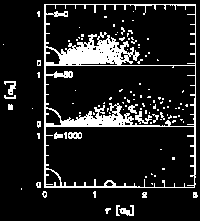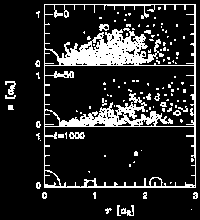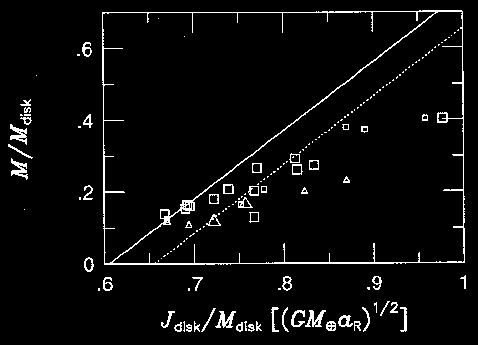Lunar Accretion from an Impact-Generated Disk
Shigeru Ida* +, Robin M. Canup+ & Glen R. Stewart+
* Department of Earth and Planetary Sciences, Tokyo
Institute of Technology, Meguro-ku, Tokyo 152. Japan
+ LASP, University of Colorado, Boulder, CO
80309-0392, USA
The formation of the Moon is still an open problem. One
possible formation hypothesis is accretion from a circumterrestrial disk
that was generated by a giant impact on the Earth. Direct N-body simulations
show that a single large moon accretes from the disk in a time scale of
a month to a year. We present a direct relationship between the size of
the formed moon and the initial configuration of the disk, which gives
an important clue to the Moon formation problem.
Many models have been proposed for formation of the Moon, but no
one has succeeded to show the formation satisfactorily. The popular "Giant
Impact" scenario states that a Mars-sized protoplanet hit the proto-Earth
and generated a circumterrestrial debris disk from which the Moon accretes.
This scenario has been favored since it may well account for the dynamical
and geochemical characteristics of the Moon (large angular momentum of
Earth-Moon system, depletion of volatiles and iron). Many hydrodynamic
simulations (a smoothed particle method) have modeled the impact process.
They calculated the impact between two large protoplanets with iron cores
and silicate mantles and followed the orbital evolution of the debris after
the impact for short time scales (~ a few orbital periods). It is found
that an impact by a Mars-sized body usually results in formation of a circumterrestrial
disk rather than direct formation of a clump. (This trend is most clear
in recent simulations.) The disk mass is usually smaller than 2.5 ML where
ML is the present lunar mass (= 0.0123 ME; ME is the Earth mass). Most
of the disk material is distributed near or interior to the radius aR of
the Roche limit (~ 2.9 RM where Re is the radius of the Earth) if the orbital
angular momentum of the impact is 1-2 JEM where JEM is the angular momentum
of the present Earth/Moon system. Within and near the Roche limit~ the
tidal force of the Earth inhibits accretional growth.
The only published accretion calculation is Canup and Esposito with
a gas dynamic approach. They approximated disk particles as particles in
a box and tracked the evolution of the mass distribution function at individual
regions of the disk, modeling velocity evolution, accretion, and rebounding
of the disk particles. They showed that, in general, many small moonlets
are formed initially rather than a single large moon and concluded that
the simplest way to form the present-sized moon is to begin with at least
a lunar mass of material outside the Roche limit. However, in gas dynamic
calculations it is difficult to include non-local effects such as radial
migration of the disk material and global interaction between formed moons
and the disk. The importance of the radial diffusion out from the Roche
limit has been pointed out through analytical argument9.
Here we perform direct N-body simulations, which automatically include
non-local effects, to investigate global lunar accretion processes. The
sequence of accretion of the moon from an impactgenerated disk may be as
follows. Initially, the disk would likely be a hot, silicate vapor atmosphere/torus.
Solid particles condense due to cooling of the disk, possibly after some
radial migration. Subsequent collisions and fragmentation of the particles
would damp initially large orbital eccentricities and inclinations of the
particles to moderate values in a few orbital periods. Our simulations
starts from this stage and follow the collisional evolution to a moon(s).
On a longer time scale, a formed moon(s) gradually migrate outward bv tidal
interaction with the Earth, sweeping remnants. We do not pursue such long
time evolution here.
We present the results of 27 simulations with different initial disk
conditions. We found that a single large moon, rather than multiple moons,
is usually formed at similar distance from the proto-Earth in 100-1000
orbital periods (~ a month to a year). We also found that the final moon
mass is mostly determined by a simple function of initial total mass and
angular momentum of the disk. In order to estimate the final moon mass,
we do not need to know the details of initial mass, size, and velocity
distributions of the disk particles. The predicted moon mass from the disks
obtained by the previous impact simulations might be as large as the present
lunar mass in some cases. However, we cannot make a definitive conclusion
at present, since the previous impact simulations did not provide enough
data about the disk angular momenta. Improved simulations are needed to
provide total mass and angular momentum of the disk. The combination of
more refined N-body and impact simulations would clarify whether a giant
impact could indeed have produced the Moon or not.
Model Description
We simulated the formation of a moon from a (three-dimensional) circumterrestrial
debris disk initially consisting of 1000-2700 particles with mass m ~ l0e-5
- 10e-2 ML, assuming that solid particles had condensed and attained such
sizes through accretion. (In the inner part of the disk, the particles
may remain very small, since accretion becomes increasingly inhibited inside
the Roche limit. Furthermore, the disk material may remain liquid due to
longer cooling time in the inner part. We will comment on these effects
later.)
We calculated disks with as many different initial conditions as
possible, since we do not have enough knowledge about disk conditions after
the vapor/liquid phase and initial collisional evolution The parameters
we examined are summarized in Table l, where we show 19 runs of the 27
simulations for which we retained detailed output data. As shown below,
the final outcome of accretion has only a weak dependence on the details
of conditions of a starting disk. We scale the orbital radii by the Roche
radius defined by aR = 2.456(pE/p)e1/3RE where (pE,/p) is the ratio of
the internal density of the Earth to that of the disk particles. For disk
particles with p = 3.34g/cm3 (the bulk density of the Moon), aR is located
at about 2.9RE. Using aR, physical radii of disk particles with mass m
are given by R = (1/2.456)(m/ME)e1/3 aR, independent of (pE/p).
Near the Roche radius, tidal forces of the proto-Earth affect w hether
colliding particles rebound or accrete. Interior to about 0.8aR, tidal
forces preclude accretion, w hile in the transitional zone 0.8-1.35aR,
limited accretional growth can occur. Exterior to this zone, accretion
is largely unaffected by tidal forces. This transitional zone will be referred
to as the "Roche zone'`. \Ne adopt here the accretional criteria of Canup
and Esposito which include this transition in addition to the impact velocity
condition that for accretion, the calculated rebound velocity must be smaller
than some critical value corresponding to (mutual) surface escape velocity.
If the colliding bodies in our simulation satisfy the criteria, we produce
a merged body, conserving momentum. If not, the bodies rebound with given
restitution coefficients.
 Figure
1. Snapshots of disk particles are plotted in geocentric cylindrical coordinates
(r, z). (Particles at negative z are plotted at abs(z) ) The units of length
and time are the Roche limit radius aR and kepler time TKep at aR(~ 7 hours).
Solid and dotted circles are disk particles and the Earth. The sizes of
the circles exprese physical sizes. The snapshots here are the result of
run 4. The mean specific angular momentum Jdisk/Mdisk is initially 0.692(G
ME aR)1/2. At t = 1500, the moon has the mass 0.40 ML, the semimajor axis
1.20 aR, the eccentricity 0.09, and the inclination (radian) 0.02. Second
body's mass is only 0.025ML. The mass ejected from the system (MJ) and
that hit the Earth are 0.026ML and 1.95ML, respectively. Figure
1. Snapshots of disk particles are plotted in geocentric cylindrical coordinates
(r, z). (Particles at negative z are plotted at abs(z) ) The units of length
and time are the Roche limit radius aR and kepler time TKep at aR(~ 7 hours).
Solid and dotted circles are disk particles and the Earth. The sizes of
the circles exprese physical sizes. The snapshots here are the result of
run 4. The mean specific angular momentum Jdisk/Mdisk is initially 0.692(G
ME aR)1/2. At t = 1500, the moon has the mass 0.40 ML, the semimajor axis
1.20 aR, the eccentricity 0.09, and the inclination (radian) 0.02. Second
body's mass is only 0.025ML. The mass ejected from the system (MJ) and
that hit the Earth are 0.026ML and 1.95ML, respectively. |
 Figure
2. The same snapshots as Fig. 1 for run 9 of a more extended disk (Jdisk/Mdisk
= 0 813 At t = 1000, the largest moon mass is 0.71ML. Figure
2. The same snapshots as Fig. 1 for run 9 of a more extended disk (Jdisk/Mdisk
= 0 813 At t = 1000, the largest moon mass is 0.71ML. |
 Figure
3. The same snapshots as Fig. 1 for run 13 of a very extended disk (Jdisk/Mdisk
= 0.958(G ME aR)e1/2. In this case, two large moons are formed. At t =
1000, the largest moon has the mass 0.63ML and the semimajor axis 1.98aR,
while the second one has 0.391ML and 0.93aR. Figure
3. The same snapshots as Fig. 1 for run 13 of a very extended disk (Jdisk/Mdisk
= 0.958(G ME aR)e1/2. In this case, two large moons are formed. At t =
1000, the largest moon has the mass 0.63ML and the semimajor axis 1.98aR,
while the second one has 0.391ML and 0.93aR. |
 Figure
4. Final moon mass M is plotted on M/Mdisk - Jdisk/Mdisk plane. Smaller
Jdisk/Mdisk cases are confined disks with smaller amax and larger q. Solid
fine is the analytical estimate with MJ = 0 and dotted line is that with
MJ = 0.051Mdisk. Squares are N-body results with en = 0.01 and triangles
are with en = 0.5. The small squares and triangles are the cases where
the mass of a second moon is larger than 30% of the largest one's mass.
In these cases, we plotted the sum of the largest and the second moons'
masses. Here we plotted all the resulte of the 27 simulations. Figure
4. Final moon mass M is plotted on M/Mdisk - Jdisk/Mdisk plane. Smaller
Jdisk/Mdisk cases are confined disks with smaller amax and larger q. Solid
fine is the analytical estimate with MJ = 0 and dotted line is that with
MJ = 0.051Mdisk. Squares are N-body results with en = 0.01 and triangles
are with en = 0.5. The small squares and triangles are the cases where
the mass of a second moon is larger than 30% of the largest one's mass.
In these cases, we plotted the sum of the largest and the second moons'
masses. Here we plotted all the resulte of the 27 simulations. |
References
1. Boss, A. P. & Peale, S. J. Dynamical constraints on the origin
of the Moon. In Origin of the moon. eds. W. K. Hartmann, R. J. Phillips,
& Taylor, G. J., Lunar and Planetary Institute, Houston, pp. 59-102
(1984).
2. Hartmann, W. K. & Davis, D. R. Satellite-sized planetesimals
and lunar origin Icarus 24, 504-515 (1975).
3. Cameron, A. G. W. & Ward, W. R. The origin of the Moon. Proc.
Lunar Planet Sci. Conf. 7th, 120-122 (1976). 4. Benz, W., Slattery, W.
L. & Cameron, A. G. W. The origin of the Moon and the single impact
hypothesis I. Icarus 66, 515-535 (1986).
5. Benz, W., Cameron, A. G. W. & Melosh, H. J. The origin of
the Moon and the single impact hypothesis III. Icarus 81, 113-131 (1989).
6. Cameron, A. G. W. & Benz, W. The origin of the Moon and the
single impact hypothesis IV. Icarus 92, 204-216 (1991).
7. Cameron, A. G. W., The origin of the moon and the single impact
hypothesis V. Icarus 126, 126-137 (1997).
8. Canup, R. M. & Esposito, L. W. Accretion of the Moon from
an Impact-Generated Disk. Icarus 119, 427-446 (1996).
9. Ward, W. R. & Cameron, A. G. W. Disc evolution svithin the
Roche limit. Proc. Lunar Planet Sci. Conf. 9th, 1205-1207 (1978).
10. Stevenson, D. J. Origin of the moon-the coliision hypothesis,
Ann. Rev. Earth Planet Sci. 15, 271-315 (1987).
11. Makino, J. ~ Aarseth, S. J. On a Hermite integrator with Ahmad-Cohen
scheme for gravitational many-body problema. Publ. Astron. Soc. Jpn. 44,
141-151 (1992).
12. Makino, J. A modified Aarseth code for GRAPE and vector processors.
Publ. Astron. Soc. Jpn. 43, 859-876 (1991).
13. Canup, R. M. & Esposito, L. W. Accretion in the Roche zone:
co-existence of rings and ringmoons. Icarus 113, 331-352 (1995).
14. Goldreich, P. and Tremaine, S. The d~vnamics of planetary rings.
Ann. Rev. Astron. Astrophys. 20, 249-248 (1982).
15. Stewart, G. R. & Wetherill, G. W. Evolution of planetesimal
velocities. Icarus 74, 542-553 (1988).
16. Safronov, V. S. Evolution of the protoplanetary cloud and formation
of the earth and planeta. Nauka Press (1969).
17. Lin, D. N. C. & Papaloizou, J. C. B. On the tidal interaction
bet~veen protostellar disks and companions. In Protostars and Planets III,
eds. E. H. Levy and J. I. Lunine, Univ. of Arizona Press, pp.749-836 (1993).
Questions & Answers
Subject: lunar question
Date: Thu, 16 Oct 1997 10:01:31 -0600
From: canup@sargon.colorado.edu (Robin Canup)
To: aparra1@pie.xtec.es (Tony Parra)
On the paper "Lunar accretion...", at page
2, I've found a statement I would like to understand better: "a former
moon(s) gradually migrate outward by tidal interaction with the Earth,
sweeping remnants". I know the fact since long time ago, but I'm not able
to explain it.
Regards,
Tony
Hi Tony:
The moon (or anything else in Earth orbit for that matter) orbitally
evolves due to "tidal interaction" with the Earth. The gravity of the moon
raises tidal bulges on the near and far side of the Earth (these are the
diurnal oceanic tides). The formation of these bulges represent an asymmetry
in the gravitational potential of the Earth (in addition to the Earth's
oblateness of course) which exerts a torque on an orbiting body. If the
orbiting body is located within geosynchronous orbit (the orbit at which
the orbital period=the rotational period or day of the Earth), then this
torque causes a moon to evolve inward towards the Earth. For a moon outside
geosync. orbit, the tidal torque causes angular momentum to be transferred
from the Earth's rotation to the orbit of the moon, causing the Earth's
spin to slow and the moon's orbit to expand. This is currently the case
for our moon. Now the rate of this expansion is proportional to the mass
of the orbiting moon (since a bigger moon produces a bigger tidal bulge
on the Earth, which in turn provides a bigger torque). So an inner massive
moon will overtake outer smaller moons as they all evolve due to tides:
this is the origin of the sentence in the Nature paper that you referred
to.
Hope this helped,
Robin.
 Figure
1. Snapshots of disk particles are plotted in geocentric cylindrical coordinates
(r, z). (Particles at negative z are plotted at abs(z) ) The units of length
and time are the Roche limit radius aR and kepler time TKep at aR(~ 7 hours).
Solid and dotted circles are disk particles and the Earth. The sizes of
the circles exprese physical sizes. The snapshots here are the result of
run 4. The mean specific angular momentum Jdisk/Mdisk is initially 0.692(G
ME aR)1/2. At t = 1500, the moon has the mass 0.40 ML, the semimajor axis
1.20 aR, the eccentricity 0.09, and the inclination (radian) 0.02. Second
body's mass is only 0.025ML. The mass ejected from the system (MJ) and
that hit the Earth are 0.026ML and 1.95ML, respectively.
Figure
1. Snapshots of disk particles are plotted in geocentric cylindrical coordinates
(r, z). (Particles at negative z are plotted at abs(z) ) The units of length
and time are the Roche limit radius aR and kepler time TKep at aR(~ 7 hours).
Solid and dotted circles are disk particles and the Earth. The sizes of
the circles exprese physical sizes. The snapshots here are the result of
run 4. The mean specific angular momentum Jdisk/Mdisk is initially 0.692(G
ME aR)1/2. At t = 1500, the moon has the mass 0.40 ML, the semimajor axis
1.20 aR, the eccentricity 0.09, and the inclination (radian) 0.02. Second
body's mass is only 0.025ML. The mass ejected from the system (MJ) and
that hit the Earth are 0.026ML and 1.95ML, respectively. 

 Figure
4. Final moon mass M is plotted on M/Mdisk - Jdisk/Mdisk plane. Smaller
Jdisk/Mdisk cases are confined disks with smaller amax and larger q. Solid
fine is the analytical estimate with MJ = 0 and dotted line is that with
MJ = 0.051Mdisk. Squares are N-body results with en = 0.01 and triangles
are with en = 0.5. The small squares and triangles are the cases where
the mass of a second moon is larger than 30% of the largest one's mass.
In these cases, we plotted the sum of the largest and the second moons'
masses. Here we plotted all the resulte of the 27 simulations.
Figure
4. Final moon mass M is plotted on M/Mdisk - Jdisk/Mdisk plane. Smaller
Jdisk/Mdisk cases are confined disks with smaller amax and larger q. Solid
fine is the analytical estimate with MJ = 0 and dotted line is that with
MJ = 0.051Mdisk. Squares are N-body results with en = 0.01 and triangles
are with en = 0.5. The small squares and triangles are the cases where
the mass of a second moon is larger than 30% of the largest one's mass.
In these cases, we plotted the sum of the largest and the second moons'
masses. Here we plotted all the resulte of the 27 simulations.